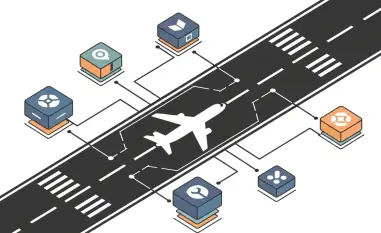In today’s fast-paced digital landscape, businesses are increasingly turning to autonomous systems to streamline operations, with agentic AI emerging as a game-changer in organizational efficiency, promising to revolutionize workflows across various industries. However, a staggering reality looms large: the rapid adoption of such technology often outpaces the security measures designed to protect sensitive data and systems. This review dives deep into the realm of agentic AI security, exploring its core components, real-world implications, and the pressing challenges that demand immediate attention. The goal is to assess whether this transformative technology can balance innovation with robust protection in an era of escalating cyber threats.
Core Features and Security Framework
Defining Agentic AI and Its Integration
Agentic AI refers to autonomous systems embedded within business processes to execute tasks with minimal human intervention. Major technology vendors have integrated these agents into platforms that power critical operations, enabling seamless automation in areas like customer relationship management and data processing. The appeal lies in their ability to enhance productivity by handling repetitive or intricate functions, freeing up human resources for strategic roles. Yet, this very autonomy introduces unique vulnerabilities, as these systems often interact with vast enterprise data repositories, raising questions about access control and potential misuse.
Shared Responsibility Model in Security
A pivotal aspect of securing agentic AI lies in the shared responsibility model, which delineates accountability between vendors and customers. Vendors bear the burden of designing inherently secure systems, incorporating protective mechanisms like enforced multifactor authentication to safeguard entry points. On the other hand, customers must manage data permissions and ensure secure usage practices within their environments. This division, while logical in theory, often blurs in practice, creating gaps where neither party fully addresses emerging risks, thus exposing organizations to potential breaches.
Data Access and Flow Controls
Unlike traditional software, agentic AI systems typically do not store data but access existing enterprise repositories, making data flow controls a critical security feature. Customers are tasked with implementing stringent access policies to prevent unauthorized exposure, a responsibility akin to securing data in cloud or SaaS environments. Vendors contribute by offering tools and protocols to support secure interactions, yet the onus remains on organizations to configure these settings correctly. This dynamic underscores the technical complexity of ensuring that data remains protected while enabling the functionality that makes agentic AI so valuable.
Performance and Real-World Impact
Industry Adoption and Competitive Dynamics
The integration of agentic AI into business operations has accelerated, with industries like customer relationship management leading the charge through platforms that automate client interactions. This rapid deployment reflects a competitive drive among vendors to outpace rivals by enhancing capabilities, often at the expense of thorough security vetting. While this push for innovation delivers immediate operational gains, it frequently leaves systems vulnerable to novel attack vectors, highlighting a critical performance gap between functionality and protection.
Emerging Risks and Vulnerabilities
Real-world applications of agentic AI have exposed significant risks, such as data exfiltration through techniques like prompt injection. Specific vulnerabilities have demonstrated how misconfigured systems can inadvertently leak sensitive information, posing severe threats to organizational integrity. These incidents emphasize the need for robust configurations and continuous monitoring to mitigate risks, as even minor oversights in permission settings can lead to substantial data breaches. The performance of agentic AI, therefore, hinges not just on its autonomous capabilities but also on the strength of its security architecture.
User Behavior as a Performance Bottleneck
An often-overlooked factor in the performance of agentic AI systems is user behavior, which can significantly undermine even the most sophisticated security measures. Employees may inadvertently grant excessive permissions or fail to follow secure workflows, creating entry points for exploitation similar to those seen in phishing attacks. This human element reveals a critical limitation in the technology’s effectiveness, as the lack of adequate training and awareness can render advanced safeguards obsolete, necessitating a focus on user education alongside technical solutions.
Challenges and Limitations
Technical Hurdles in Outpacing Threats
Securing agentic AI faces substantial technical challenges, as novel attack methods continue to evolve faster than corresponding defenses. Cybercriminals exploit the autonomy of these systems through innovative tactics that bypass traditional safeguards, leaving both vendors and customers scrambling to adapt. This constant lag in security development poses a significant barrier to the reliable performance of agentic AI, demanding ongoing research and updates to address ever-changing threat landscapes.
Operational Gaps and Over-Reliance on Tools
Operationally, organizations often struggle with inadequate training and an over-reliance on vendor-provided security tools like data loss prevention systems. Such tools, while useful, can foster a false sense of security, leading to neglect of internal architectural solutions that are crucial for comprehensive protection. This dependency highlights a limitation in the current approach to agentic AI security, where operational readiness fails to match the complexity of the technology being deployed.
Policy and Education Deficiencies
Beyond technical and operational issues, the absence of clear policies and effective education programs presents a formidable challenge. Many organizations lack structured guidelines for securely integrating agentic AI into their workflows, resulting in inconsistent practices that heighten vulnerability. Addressing this gap requires a concerted effort to develop standardized protocols and invest in user training, ensuring that the workforce is equipped to handle the nuances of autonomous systems without compromising data integrity.
Final Assessment and Path Forward
Reflecting on this evaluation, it becomes evident that agentic AI stands as a transformative force in business technology, offering unparalleled efficiency while simultaneously exposing significant security flaws. The shared responsibility model, though conceptually sound, often falters in execution due to unclear boundaries and evolving threats. Real-world vulnerabilities and user-related risks further compound the challenges, revealing a technology whose potential is matched by its perils.
Looking ahead, actionable steps emerge as critical for stakeholders. Vendors need to prioritize security in their development cycles, embedding stronger guardrails and proactive protections from the outset. Customers, in turn, must commit to rigorous access control policies and comprehensive training programs to mitigate human error. Collaborative efforts between both parties promise to bridge existing gaps, potentially through industry-wide standards that could elevate security practices over the coming years.
Ultimately, the journey toward secure agentic AI demands a shift in mindset, viewing security not as an afterthought but as an integral component of innovation. By fostering better tools, policies, and awareness starting now, the industry can pave the way for a future where autonomous systems deliver their full potential without compromising the trust and safety of the organizations relying on them.













